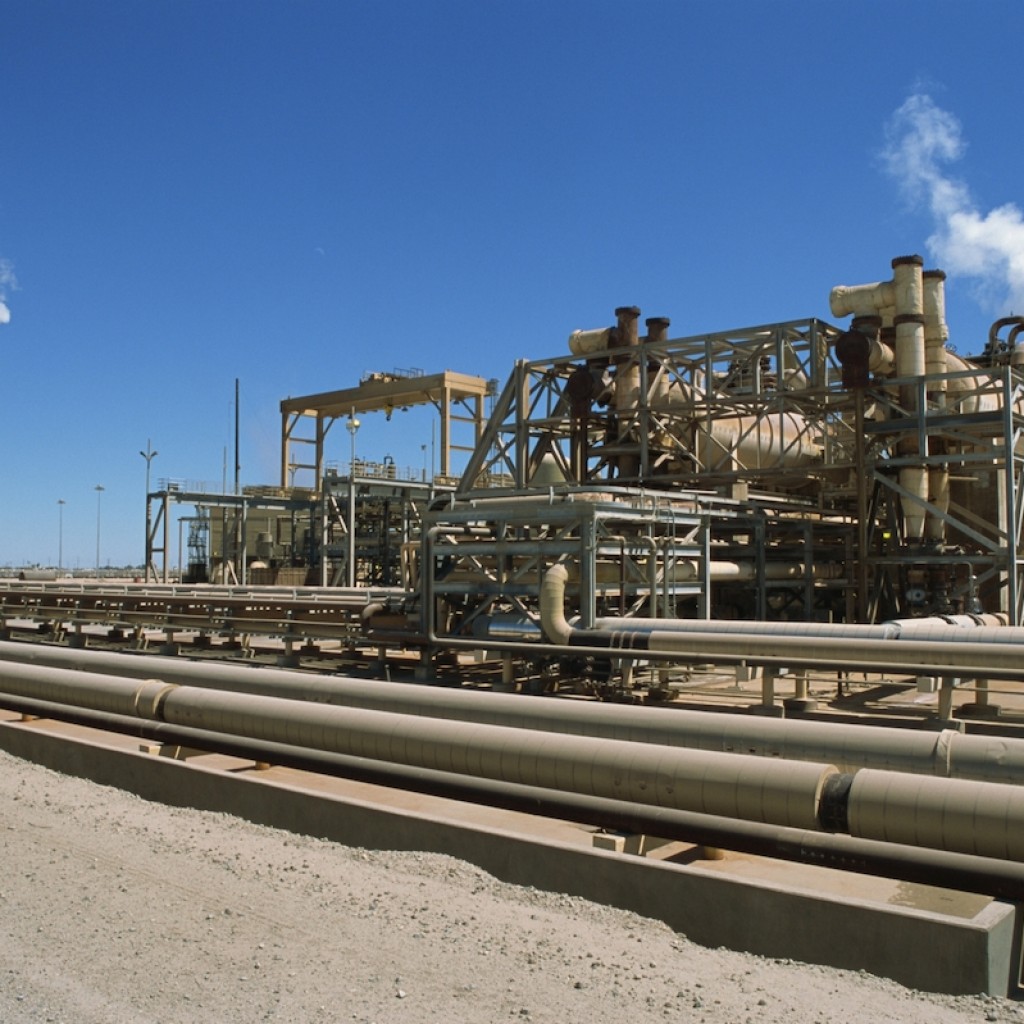
A spike in demand for electricity from tech companies competing in the artificial intelligence race is upending forecasts for natural gas-fired power in the U.S., as utilities reconsider it as a major new power source.
That is not what many scientists and climate activists envisioned in the fight against climate change. And it is endangering progress on the greenhouse gas-reduction goals that scientists say are necessary to manage the damage from burning fossil fuels that warms the planet.
Across the nation, tech companies are snapping up real estate and seeking new power projects to feed their energy-hungry operations.
In some cases, Big Tech is building climate-friendlier projects like solar, wind, geothermal or battery storage.
But industry decision-makers are also turning to natural gas for what they say is a cheap and reliable source of power, raising the prospect that gas-fired power will play a bigger role — and for a longer period of time — than even they had anticipated.
“Gas is growing faster now and in the medium term than ever before,” said Corianna Mah, a power and renewables analyst at data analytics firm Enverus.
Before the spike in electricity demand last year, many in the industry had assumed that there would be few new gas plants and that the nation’s fleet would gradually retire in favor of a grid powered by wind, solar, geothermal, batteries and possibly the next generation of nuclear power — sources that don’t emit the planet-warming greenhouse gas carbon dioxide.
For many countries, that ramp down is happening as they work toward the goal of slashing their emissions to zero — or at least, net zero — by 2050, which scientists say could help the world avoid the worst effects of climate change.
In the U.S., the electric power sector is the second-biggest emitter of greenhouse gases, according to government figures. And the construction of every new natural gas plant — built to last for decades — is a setback for climate goals, said John Quigley, a senior fellow at the University of Pennsylvania’s Kleinman Center for Energy Policy.
“At a top level, we will not get to net zero by 2050 if we are building new gas plants. Period,” Quigley said.
Burning natural gas emits carbon dioxide, and before that, when it escapes from wellheads or pipelines in its unburned form, it’s an even more potent greenhouse gas called methane.
Quigley and others say there is enough solar, wind and battery storage projects on the drawing board to satisfy growing electricity demand. But, they say, utilities and grid operators lack the will to abandon natural gas.
Enverus now projects the next five years will bring roughly 46 gigawatts of gas-fired power online. That compares to 39 gigawatts in the past five years, it said.
Announcements last year alone include:
— two 705-megawatt plants by Evergy in Kansas;
— Entergy’s 2,300-megawatt plant to serve Meta’s $10 billion AI data center in northern Louisiana, a pair of new plants in Texas and another in Mississippi;
— a 1,450-megawatt plant by the Tennessee Valley Authority;
— a 1,400 megawatt Duke Energy project in North Carolina;
— and Georgia Power’s plans for three oil or gas units with a capacity of up to 1,300 megawatts.
And that’s not all.
Calpine said it’s exploring new gas-fired capacity in the congested mid-Atlantic region, especially Pennsylvania and Ohio, where analysts say the grid operator is trying to fast-track new gas-fired power plants into service.
In Pennsylvania, the former Homer City coal-fired power plant is being transformed into a massive gas-fired station that’s expected to supply a data center — and got a $5 million state grant to do it.
On top of the artificial intelligence boom, the frenzy for new electricity is fueled by cryptomining, the broader electrification of society and a bipartisan push to bring manufacturing back to the U.S.
It is coinciding with the closure of coal plants and aging nuclear plants, unable to compete with cheaper gas, solar and wind.
Across the U.S., gas pipeline operators are exuberant about the new demand and are reporting strong interest in extending their lines.
Chris Kalnin, the CEO of BKV, the largest natural-gas producer in the Barnett Shale gas reservoir in Texas, said the trend there is toward gas plants being built next to data centers in a booming data center corridor in metropolitan Dallas.
Data center developers there are in an “arms race” to secure power, Kalnin said.
“Data center guys are trying to source power and trying to get to market with their data centers as fast as possible,” Kalnin said. The key to signing up cloud-computing customers “is getting your facility online quickly and getting your facility online quickly requires you to have power and dependable power and a cost-efficient power source.”
Rob Jennings of the American Petroleum Institute, said the sudden growth in actual and forecast electricity demand has put a premium on power sources that can be built fast and cheaply and are reliable.
That means natural gas is once again attractive to investors over solar and wind, he said.
“In the near term, the reality has dawned on most that it has to be gas,” Jennings said.
Industry officials say they strive to deliver electricity that is clean, reliable and affordable.
For instance, some new gas plants are replacing higher-pollution coal-fired plants, some are designed to run only at times of high demand, some are paired with battery storage or a wind farm nearby and some are designed with carbon-capture technology or to run on a hydrogen blend, said Alex Bond of the Edison Electric Institute, which represents U.S. investor-owned electric companies.
At the very least, building gas-fired capacity will have high-level political support.
In his remarks to the World Economic Forum in Davos, Switzerland last month, President Donald Trump declared that he’d issue “emergency declarations” to get coal – and gas-plants built to make the U.S. a superpower of manufacturing, cryptomining and artificial intelligence.
But Amanda Levin of the Natural Resources Defense Council said the U.S. must take big steps by 2035 to reduce its reliance on gas.
That means slashing a fleet of roughly 1,500 gas plants down to about 100 if the U.S. is to meet strong climate commitments and preserve a chance of addressing climate change, she said.
Still, she said there are reasons to be optimistic that gas plant projects on the drawing board won’t get built.
In recent weeks, Chinese tech startup Deepseek released a new AI model that it boasted was on par with similar models from U.S. companies and at a fraction of the cost — calling into question the need for a massive expansion of energy-hungry data centers.
And some analysts believe utilities overestimate the electricity they’ll need, essentially by double- or triple-counting data center proposals when firms express interest in multiple locations — but only build in one.
Besides, Levin said, data center operators are getting better at energy efficiency, particularly in how they cool their servers.
Even if all the gas plants are built, they may not get used, she said.
“There are a lot of reasons,” Levin said, “for why we might not actually see all of this (demand) materialize.”
___
Republished with permission of the Associated Press.



One comment
Ron Ogden
February 27, 2025 at 11:03 am
“. . .scientists and climate activists envisioned in the fight against climate change.”
Scientists and climate activists have lost that fight, and here is why:
1/the climate has been warming for 12,000 years. The rate of warming waxes and wanes. The massive overhaul, and weakening, of the American economy through changing to more windy wind and smiley sun is not going to change it in your lifetime or mine. It is not useful.
2/Protecting our economy against the effects of a warming climate is a serious problem. The only way to meet it is with more energy use, not less;
3/The global economy runs on abundant energy, and fossil fuel remains the most efficient way to get it. Until the climate lobby wises up and starts promoting nuclear on a large scale, the demand for fossil will continue–and the climate lobbyists will continue to draw their paychecks for beating dead horses. I guess I see why they do it. Where the h— is John Kerry these days? Probably on a jet to somewhere, burning more than his fair share of fossil.
Comments are closed.